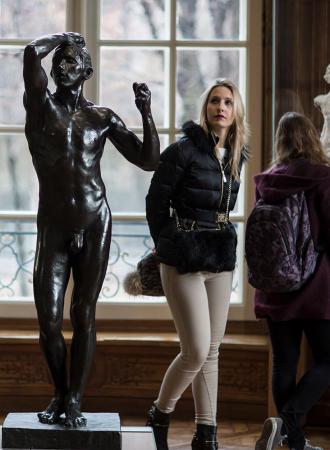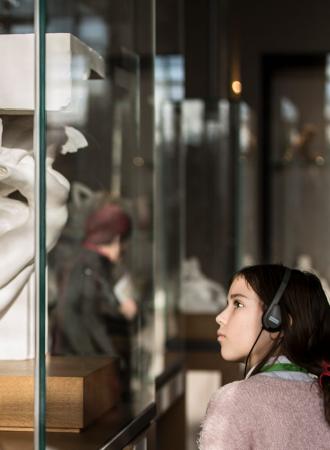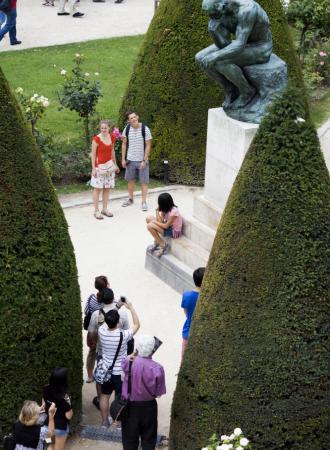Search the site
Call for papers : 'The Myth of the Sculptor, or Mythical Sculptors'
THE MYTH OF THE SCULPTOR, OR MYTHICAL SCULPTORS
SYMPOSIUM
PARIS, Musée DU LOUVRE, TUESDAY JUNE 16th 2026
PARIS, MUSée rodin, WEDNESDAY JUNE 17tH 2026
On the occasion of the Louvre’s upcoming exhibition on Michelangelo and Rodin, the Musée du Louvre, in partnership with the Musée Rodin, is organising a symposium entitled ‘The Myth of the Sculptor, or Mythical Sculptors’, under the direction of exhibition curators Chloé Ariot and Marc Bormand. This call for papers is open to all specialists and researchers, whether in the cultural heritage sector or the education sector, whether starting their careers or already established.
Michelangelo Buonarroti, known as Michelangelo (1475–1564) and Auguste Rodin (1840–1917) occupy essential – or rather, central – places in the history of Western sculpture. They are both known as geniuses, two towering artists who came to embody the figure of the sculptor, each in his own time and without question, leaving an echo that has since continued and grown louder.
Artistic renown is well studied today, especially since the Ernst Kris and Otto Kurz’s foundational 1934 work, The Legend of the Artist, analysing how the myth of the artist is built, from half-mads autodidact to the demigods of innate talent. Artist biographies became fashionable in the Renaissance, inspired by classical antiquity, and in particular by Giorgio Vasari’s Lives of the Most Excellent Painters, Sculptors and Architects, published in 1550 and again in 1568, which combined the real and the imaginary, based on the legends of the saints. With the rise of Romanticism in the 19th century came the soon well-established figure of the solitary genius, marginalised and misunderstood but with visionary inspiration. Thus, artists across the ages have been depicted as endowed with divine genius. Michelangelo, after all, was known as Il Divino (‘the divine one’) by his contemporaries. Rodin’s detractors often derisively compared him to God the Father.
But we shall not limit ourselves to simple observations of these two artists’ mythical status. The construction of the myth of Michelangelo in the artist’s lifetime is no longer in dispute, having been keenly traced and analysed by Guillaume Cassegrain in his recent work Michel-Ange, origines d’une renommée (Paris, Hazan, 2019). Mirroring the myth of Michelangelo is the creation of the myth of Rodin, brilliantly demonstrated by Sara Vitacca in her thesis on ‘Michelangelisms’: A Myth in Action: the Reception of Michelangelo Between 1875 and 1914 (Dijon, Presses du Réel, 2023; in French).
The mythical dimensions of Michelangelo and Rodin raise in fact another question. These two sculptors – one of whom was also a renowned painter, architect and poet, and the other a famed draughtsman – have been gradually identified in the collective imagination as two incarnations of the sculptor, to the detriment of their other talents. Is the power of their sculpted works alone enough to explain this oversimplification? Or does the figure of the sculptor conceal some particular myth-generating force? In short, is there a distinctive ‘myth of the sculptor’?
There are a number of leads to be explored:
- In the Genesis myth, for example, God creates Adam and Eve out of clay. Is sculpture then the original art form? How best to understand the myth of Pygmalion? What is the role of sculpture in the creation of the intellectual category of ‘primitive’ arts in the early 20th century?
- The figure of the demiurge: why is the figure of the sculptor so particularly demiurgic? Is there a link between Renaissance art and the paragone dispute, or was it a consequence of the realities of creation and material limitations?
- The role of collaborators in the sculptor’s workshop: the sheer materiality of sculpture requires a team of others working with the artist. How then should we relate the sculptor’s workshop and the collective dimension of sculptural creation to the myth of the demiurgic artist? What position(s) do sculptures take on in relation to this complex environment?
- (Self-)mythmaking: the role and definition of the sculptor change from one era to the next, but seen from today’s perspective, the figure of the sculptor can seem unchanging. Did the various academies established in the early modern period play a role in this construction? What topoi are found in the writings, tributes and monuments contributing to the mythification of the sculptor? In the positions sculptors themselves adopt in seeking to edify their own myths? What role do the artworks themselves play in spreading myths?
- The myth trap: there are far fewer great sculptors than there are great painters or architects. How to understand this? Is access to mythical status different or more rare for sculptors? How to define oneself as a sculptor in relation to the mythical sculptors of the past? How to be – or become – a female sculptor in relation the mythical male sculptor? Is the myth of the sculptor compatible with the reality of the art of sculpture? What happens to this myth in contemporary art?
These prompts are far from exhaustive. Submissions may focus on a particular sculptor, on a specific time period or cultural area, from antiquity to modern times, or take a diachronic approach to an idea or concept.
PROPOSALS
Proposals should include a title, an abstract (1500–2000 characters) and a short profile of the author (500–1000 characters). Proposal must be received no later than 15 December 2025 at colloques@musee-rodin.fr.
Selected proposals will have 25 minutes’ presentation time, followed by time for a Q&A with the audience.
SCIENTIFIC AND ORGANISATIONAL COMMITTEE
MUSée rodin
- Amélie Simier, Senior Heritage Curator, Director of the Musée Rodin
- Chloé Ariot, Heritage Curator, Manager of Sculpture Collection at the Musée Rodin, Exhibition Curator
- Véronique Mattiussi, Head of Research Division, Musée Rodin
- Franck Joubin, Researcher and Symposium Coordinator, Musée Rodin
MUSée du louvre
- Marc Bormand, Senior Heritage Curator, Medieval and Renaissance Italian Sculpture, Musée du Louvre, Exhibition Curator
- Julie Botte, Project Coordinator, Department of Museum Studies and Research Support, Research Support Division, Musée du Louvre
- Philippe Cordez, Deputy Director of the Department of Museum Studies and Research Support, Head of Research Support Division, Musée du Louvre

Visual : Jacques-Ernest Bulloz, La Main de Dieu d'Auguste Rodin, après 1918, épreuve gélatino-argentique virée, Paris, musée Rodin, Ph.04857 © musée Rodin - photo Jean de Calan.
Call for Papers
- Call for Papers(pdf, 830.6 ko)





